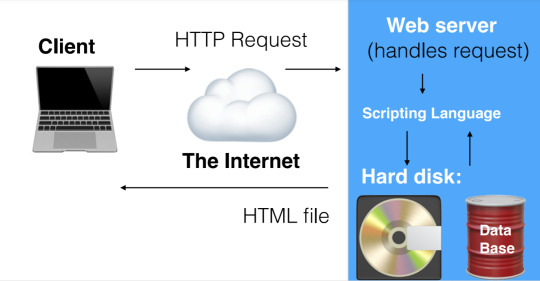#moodle custom sql queries
Explore tagged Tumblr posts
Video
youtube
How to Create Moodle Custom Report Using SQL Queries on LearnerScript?
#moodle-custom sql report queries#moodle custom report builder#moodle custom sql reports#Custom Reports Via SQL Queries#Moodle configurable reports#Moodle report builder#moodle reporting dashboard#moodle analytics dashboard#reporting plugins for moodle#moodle student report#moodle reports plugin#moodle custom sql queries
0 notes
Text
LET’S TALK DYNAMIC WEBSITES

So far we have been looking at client-side technologies, such as HTML & CSS.
All modern websites are made from HTML, CSS & JavaScript.
But almost all are also built using server-side technologies, including scripting languages and a database.
STATIC WEBSITES
Where the content does not change unless you change the source code.
How static website is delivered:

DYNAMIC WEBSITE
Here, the server application constructs the page, usually using a scripting language in conjunction with a database.
In the dynamic world, The content of the page may change depending on input (forms filled in) or user logins etc.
How to deliver a dynamic website:

SCRIPTING LANGUAGE
It is also known as server side
Server-side scripts run on a web server and interpret requests to provide customized web pages depending on the user's request.
Examples of scripting languages: PHP, ASP, Python, Ruby, Java.
Java
You can write server processes using Java
JavaScript was traditionally known as a client-side scripting language, but now with technologies such as node.js it is often used on the server-side too.
PHP
PHP is a popular server-side scripting language.
PHP stands for: PHP: Hypertext Pre-processor.
This is a hypertext-pre processor meaning it processes before the scripting language.
PHP code must be executed by a PHP interpreter which must be installed a module on a web server.
A browser does not understand PHP (unlike, say, HTML or JavaScript) If you purchase web hosting it usually includes PHP
PHP code is often embedded in an HTML page.
Example:
<!DOCTYPE html>
<html lang="en">
<head>
<title>Example of PHP</title>
</head>
<body>
<?php echo '<p>Hello, World!</p>'; ?>
</body>
</html>
PHP is distinguished from HTML by it’s delimiters.
A block of PHP starts and with <?php and ends with ?>
DATABASE
This is an organised collection of data, typically stored and accessed on a computer.
A database management system is the software that allows users to interact with a database/ the software that manages the database
RELATIONAL DATABASES
A relational database organises the data into tables of rows and columns. Each record in the table is a row. Rows in different tables can be related or linked to each other.
MySQL
MySQL is a popular open-source relational database management system.
SQL stands for Structured Query Language, a language used to interact with, programme and edit databases.
PHP + MySQL
PHP and MySQL are often used together on servers to deliver dynamic webpages.
PHP is the most popular scripting language for web development. It is free, open source and server-side (the code is executed on the server). MySQL is a Relational Database Management System (RDBMS) that uses Structured Query Language (SQL). It is also free and open source.
CONTENT MANAGEMENT SYSTEMS
An application which allows users to add, edit, delete content on a website.
Example: Tumblr & Moodle-You can add, edit or delete posts without knowing any of the scripting languages
Users can run a dynamic, database driven website often without any knowledge of code.
With a Content Management System, a user can login and submit content to a website without altering any code.
Web Content Management Systems are installed on web servers.
WORDPRESS
WordPress is a popular Content Management System built using PHP and MySQL.
Originally associated with blogging, it is now used for news websites, eCommerce sites, forums, galleries, commercial sites etc.
A lot of websites which have a blog inside would have wordpress
Wordpress.com-This is like Tumblr where all the hosting is done for you
Wordpress.org-Here you have to install wordpress. Hosting is not done for you. In order to install WordPress you need a server, with PHP & MySQL (or MariaDB)
SERVER SIDE
The college has a server, Knuth.
You all have access to Knuth, to put up files and access them via a web browser.
You also have one MySQL database setup.
SFTP-Secure File Transfer Protocol
This is a piece of software that allows you to securely transfer files to a server
To access the server and put files on it, you need an SFTP Client.
To connect to the server, you will need to give your SFTP Client some information:
1. Server address
2. Port
3. Connection type
0 notes